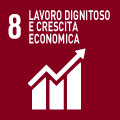- Docente: Elisabetta Carfagna
- Crediti formativi: 6
- SSD: SECS-S/01
- Lingua di insegnamento: Italiano
- Modalità didattica: Convenzionale - Lezioni in presenza
- Campus: Bologna
-
Corso:
Laurea Magistrale in
Statistica, economia e impresa (cod. 8876)
Valido anche per Laurea Magistrale in Statistical Sciences (cod. 9222)
-
dal 10/02/2025 al 17/03/2025
Conoscenze e abilità da conseguire
By the end of the course the student knows the methodologies adopted by European countries for producing official statistics on main socio-economic phenomena. Particularly, the student should be aware of the data collection and estimation methods adopted by the countries and of the main methodological issues, including the accuracy and the comparability of the official statistics produced by the different countries. The student is also able to analyse and understand the trends of socio-economic phenomena in some European and OECD countries.
Contenuti
Organisation and role of the European Statistical System (ESS) and the European System of Central Banks (ESCB) in the society.
The European statistics code of practice and its application in data production and dissemination.
Data sources, data collection, and estimation methods adopted by the institutions of ESS and ESCB, including the accuracy and the comparability of the official statistics produced by the different countries.
The trends of socio-economic phenomena in some European and OECD countries.
The procedures, methods and tools adopted by European countries for producing and disseminating official statistics on main socio-economic phenomena, including:
- Specification of needs
- Methods of data collection in official statistics
- Sampling techniques
- Survey design
- Use of administrative sources
- Integration of data from different sources
- Estimation
- Small area estimators
- Area sampling frames
- Optimisation of area sample designs
- Multiple Frame Sample Surveys
- Adaptive sampling
- Sequential sampling
- Group sequential sampling
- Use of remote sensing data for official statistics
- Analysis of socio-economic phenomena
- Quality assessment
- Dissemination of official statistics.
- Emerging statistical information needs for decision-making and possible approaches for satisfying these needs.
- New data sources, data science and citizen science
Testi/Bibliografia
European statistics code of practice, available at https://ec.europa.eu/eurostat/web/products-catalogues/-/KS-02-18-142
Handbook on Methodology of Modern Business Statistics (MEMOBUST) (will be provided) for the following topics:
- Institutions and organization of OECD, European and Italian statistical systems.
- National and international socio-economic surveys and methodological instruments to examine socio-economic phenomena.
- Steps in the statistical investigation for socio-economic phenomena at national and international levels, including:
- Specification of needs
- Methods of data collection in official statistics
- Sampling techniques
- Survey design
- Use of administrative sources
- Integration of data from different sources
- Estimation
- Small area estimators
- Analysis of socio-economic phenomena
- Quality assessment
- Dissemination of official statistics.
Cochran W.G. (1977). Sampling Techniques, third edition, Wiley, New York. Chapters to be studied:
- Introduction Chapter 1;
- Simple random sampling Chapter 2;
- Estimation of sample size Chapter 4;
- Stratified random sampling Chapter 5, from 5.1 to 5.7;
- Further aspects of stratified sampling Chapter 5A, from 5A.1 to 5A.3; from 5A.9 to 5A.11; 5A.15;
- Regression estimators Chapter, 7 from 7.1 to 7.6 and 7.10;
- Systematic sampling Chapter 8;
- Single stage cluster sampling Chapter, 9 from 9.1 to 9.4:
- Subsampling with units of equal size Chapter, 10 from 10.1 to 10.4;
- Double sampling Chapter 12, from 12.1 to 12.2;
- Sources of error Chapter 13, 13.1.
http://ec.europa.eu/eurostat/web/products-statistical-reports/-/ks-ft-18-005
for the following topic:
- Emerging statistical information needs for decision-making and possible approaches for satisfying these needs
For the following topics, material will be made available:
- Area sampling frames
- Optimisation of area sample designs
- Multiple Frame Sample Surveys
- Adaptive sampling
- Sequential sampling
- Group sequential sampling
- Use of remote sensing data for official statistics
- Use of administrative sources
- New data sources, data science and citizen science
Optional readings
·
Rodrigues P. C., Carfagna E. (2023) Data science applied to environmental sciences, Environmetrics, Volume 34, Issue 1, e2783. https://doi.org/10.1002/env.2783
Beręsewicz, M. (2017) A Two‐Step Procedure to Measure Representativeness of Internet Data Sources. International Statistical Review, 85: 473–493. doi: 10.1111/insr.12217 [https://doi.org/10.1111/insr.12217] .
· Hand D.J. (2016) Big data and data sharing. Journal of the Royal Statistical Society, Series A: Statistics in Society, 179, 1-3, http://hdl.handle.net/10044/1/33934
· Hand, D. J. (2018), Statistical challenges of administrative and transaction data. J. R. Stat. Soc. A. . doi:10.1111/rssa.12315 [https://doi.org/10.1111/rssa.12315]
· Rao, J.N.K., and Fuller, W.A. (2017). Sample survey theory and methods: Past, present, and future directions [http://www.statcan.gc.ca/pub/12-001-x/2017002/article/54888-eng.htm] . Survey Methodology, Statistics Canada, Catalogue No. 12-001-X, Vol. 43, No. 2. Paper available at http://www.statcan.gc.ca/pub/12-001-x/2017002/article/54888-eng.htm
· Tam, S.‐M., and Clarke, F. (2015) Big Data, Official Statistics and Some Initiatives by the Australian Bureau of Statistics. International Statistical Review, 83: 436–448. doi: 10.1111/insr.12105 [https://doi.org/10.1111/insr.12105]
Metodi didattici
Lectures and practicals
Modalità di verifica e valutazione dell'apprendimento
Oral exam made of two parts.
In the first part, the student must show to be able to solve exercises similar to the ones addressed in class during practicals. Excel and manuals can be used. Students are not permitted to use a mobile phone (and smart watch or similar electronic data storage or communication device). In the second part, theoretical questions are asked. The student has to show to be able to choose and apply the appropriate methods to be adopted for solving specific problems. The use of the manuals is allowed for discussing the formulas. The final mark is out of thirty.
Strumenti a supporto della didattica
PowerPoint files.
Orario di ricevimento
Consulta il sito web di Elisabetta Carfagna
SDGs



L'insegnamento contribuisce al perseguimento degli Obiettivi di Sviluppo Sostenibile dell'Agenda 2030 dell'ONU.
